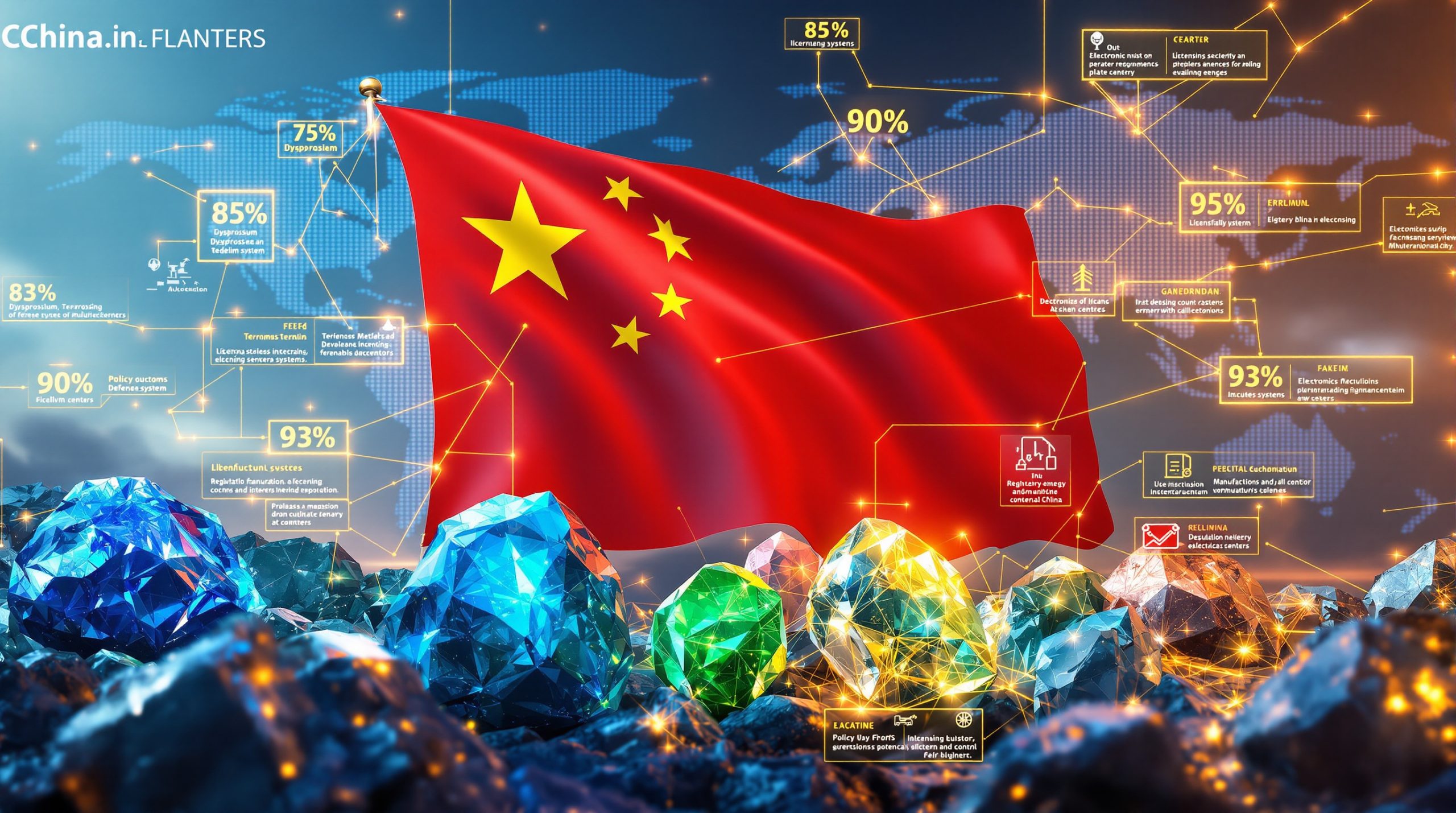China's rare earth export suspension has created significant ripple effects across global supply chains, demonstrating the complex interplay between resource control and geopolitical strategy. The recent announcement from Beijing regarding rare earth export controls has sent ripples through global markets, but the devil lies in the carefully crafted language. China's decision to suspend certain export restrictions for one year represents a masterclass in strategic ambiguity, providing flexibility while maintaining leverage over critical supply chains.
Understanding China's Rare Earth Export Suspension Strategy
The term "relevant export control measures" in China's official communications serves as a deliberate catch-all phrase that preserves maximum flexibility for Beijing's policymakers. This linguistic construction allows Chinese authorities to selectively interpret which specific restrictions fall under the suspension while maintaining plausible deniability for continued enforcement of others.
The ambiguity extends to fundamental questions about scope and implementation. Will the suspension apply to the April 4, 2025 controls, the October 9 restrictions, or both? Which government body holds the authority to determine what constitutes "relevant" measures? These unanswered questions create a framework where China can adjust its position based on evolving geopolitical circumstances without appearing to violate the spirit of the agreement.
Timeline of Events Leading to the One-Year Moratorium
The suspension emerged from high-level negotiations between President Trump and President Xi Jinping during meetings in Busan, marking a significant diplomatic development in US-China trade relations. The timing reflects Beijing's calculated response to mounting international pressure over rare earth supply chain vulnerabilities.
Key developments leading to the agreement include:
- Escalating concerns from Western allies about critical mineral dependencies
- Growing momentum behind US domestic rare earth processing initiatives
- Increasing collaboration between allied nations on alternative supply chains
- Market volatility triggered by previous Chinese export restrictions
The one-year timeframe appears strategically chosen to provide enough breathing room for immediate market stabilization while remaining insufficient for meaningful Western supply chain restructuring. Furthermore, this approach aligns with broader trends in critical minerals energy transition strategies globally.
What Does China's Suspension Actually Cover?
Understanding the practical implications of China's rare earth export suspension requires parsing through layers of bureaucratic language and regulatory complexity. The suspension's actual coverage remains intentionally opaque, creating uncertainty for global manufacturers and policymakers alike.
Decoding the Ambiguous "Relevant Export Control Measures"
The phrase "relevant export control measures" encompasses a broad spectrum of potential restrictions, from processing quotas and technology transfer limitations to dual-use application controls. This broad categorisation allows Chinese authorities to maintain discretion over which specific measures remain active during the suspension period.
Processing quotas represent one of the most immediate concerns for global supply chains. These quotas directly limit the volume of refined rare earth materials that can leave China, creating bottlenecks that affect everything from smartphone production to wind turbine manufacturing. The suspension's impact on these quotas could provide immediate relief to manufacturers facing supply constraints.
Technology transfer restrictions add another layer of complexity. These controls limit not just the flow of materials but also the knowledge and expertise necessary for establishing independent processing capabilities. The suspension's treatment of these restrictions will significantly influence the speed at which Western nations can develop domestic refining capacity.
Which Rare Earth Elements Remain Under Restriction
The suspension's coverage varies significantly across different rare earth elements, with some materials potentially remaining under strict export controls despite the broader agreement. Heavy rare earth elements, particularly those with critical defence applications, may continue facing restrictions regardless of the suspension's general provisions.
| Control Type | Status | Interpretation Risk |
|---|---|---|
| Processing quotas | Suspended | High flexibility |
| Technology transfers | Unclear | Maximum ambiguity |
| Dual-use applications | Conditional | Strategic leverage |
Elements like dysprosium and terbium, essential for advanced magnetic applications, represent particular areas of concern. These materials command premium prices and face limited global supply alternatives, making them powerful tools for economic statecraft. China's treatment of these specific elements during the suspension period will signal its broader strategic intentions.
Why Did Beijing Agree to This Trade Concession?
China's decision to suspend rare earth export controls reflects a complex calculation involving immediate economic benefits, strategic positioning, and long-term geopolitical considerations. The agreement represents less of a concession than a tactical repositioning designed to maximise China's advantages while managing international pressure.
Economic Incentives: Tariff Relief and Port Fee Reductions
The suspension agreement delivered tangible economic benefits for China through reduced tariffs and suspended port fees. These immediate financial advantages provide relief for Chinese exporters facing margin pressure from trade tensions while maintaining China's fundamental strategic position in critical mineral markets.
Tariff reductions particularly benefit China's manufacturing sector, which relies heavily on export revenues across multiple industries. The estimated financial impact of these reductions could reach billions of dollars annually, providing significant economic stimulus during a period of slower global growth. Port fee suspensions add another layer of cost savings, improving the competitiveness of Chinese goods in international markets.
The agreement also suspended new export controls from the US side, preventing additional restrictions that could have further complicated Chinese trade operations. This mutual de-escalation creates breathing room for both economies while preserving the underlying structural dynamics that favour China's position in critical mineral supply chains.
Strategic Timing: Buying Time to Strengthen Market Position
The one-year suspension provides China with valuable time to further consolidate its dominance in rare earth processing and refining capabilities. During this period, Chinese companies can expand capacity, improve efficiency, and develop new technologies while Western competitors continue struggling with permitting, funding, and technical challenges.
China's rare earth processing infrastructure continues expanding despite the suspension, with new facilities coming online and existing operations scaling up production. This expansion occurs against a backdrop of Western projects that remain years from meaningful production, widening the competitive gap rather than narrowing it.
The timing also allows China to observe and potentially influence Western supply chain development efforts. By maintaining visibility into competitor strategies and timelines, Chinese policymakers can adjust their own approach to maximise strategic advantage when the suspension expires. However, this development occurs within the broader context of Greenland critical minerals initiatives and other global supply diversification efforts.
Diplomatic Calculations in US-China Relations
The suspension serves broader diplomatic objectives by demonstrating China's willingness to engage constructively on trade issues while maintaining core strategic positions. This approach helps manage international criticism about economic coercion while preserving the fundamental tools of China's rare earth strategy.
The agreement provides both nations with political cover for domestic audiences. President Trump can claim success in securing rare earth access, while President Xi can point to meaningful tariff relief and reduced trade friction. This mutual benefit creates incentives for continued engagement despite underlying strategic competition.
How Does This Impact Global Rare Earth Supply Chains?
The suspension's effects ripple through complex global supply networks, creating both immediate relief and long-term strategic implications for manufacturers, governments, and investors worldwide. Understanding these impacts requires examining both short-term market dynamics and structural supply chain vulnerabilities.
Immediate Market Reactions and Price Stabilisation
Rare earth prices experienced notable stabilisation following the suspension announcement, with several key materials seeing reduced volatility after months of uncertainty. Neodymium and dysprosium prices, critical for permanent magnet production, showed particular responsiveness to the news as manufacturers gained confidence about near-term supply availability.
Market participants report improved contract negotiation environments, with Chinese suppliers offering longer-term pricing arrangements that were previously unavailable under export control uncertainty. This improved predictability allows manufacturers to plan production schedules and inventory management more effectively, reducing the premium costs associated with supply chain risk.
However, price stabilisation does not equate to price reduction. Many rare earth elements continue trading at elevated levels compared to pre-restriction periods, reflecting ongoing structural supply constraints and the premium associated with Chinese market dominance.
Long-Term Dependency Concerns for Western Nations
The suspension temporarily masks but does not resolve fundamental dependency issues facing Western economies. China's control over 85-90% of global rare earth processing capacity remains unchanged, leaving Western nations vulnerable to future supply disruptions regardless of current market stability.
Key Statistics:
- China controls 85-90% of global rare earth processing capacity
- Western refining projects remain 3-5 years from scaled production
- One-year timeline insufficient for meaningful supply diversification
Western governments face a critical decision point about how aggressively to pursue supply chain independence during the suspension period. The temporary relief could either catalyse accelerated investment in domestic capabilities or create complacency that perpetuates long-term vulnerabilities.
Allied coordination becomes increasingly important as individual nations lack the scale to develop comprehensive rare earth processing capabilities independently. Collaborative approaches involving technology sharing, joint ventures, and coordinated investment strategies offer the most promising path toward reduced Chinese dependency. In addition, this connects to the broader big pivot minerals strategy discussions occurring across Western governments.
What Are the Real Winners and Losers?
The suspension creates a complex landscape of winners and losers across different sectors, geographies, and timeframes. Analysing these impacts reveals important insights about the broader implications of critical mineral geopolitics and supply chain strategy.
Short-Term Benefits for Technology Manufacturers
Technology manufacturers represent the most immediate beneficiaries of the suspension, gaining access to more predictable rare earth supplies for critical production processes. Companies producing smartphones, electric vehicles, wind turbines, and defence systems can now plan operations with greater confidence about material availability.
The automotive sector particularly benefits from improved access to permanent magnet materials essential for electric vehicle motors. Major automakers had begun redesigning products to reduce rare earth content, but the suspension allows them to maintain current designs while developing longer-term alternatives.
Electronics manufacturers also gain breathing room for supply chain planning, though many continue pursuing diversification strategies as insurance against future restrictions. The suspension provides time to implement these alternatives without the immediate pressure of supply shortages.
Strategic Disadvantages for US Industrial Policy
The suspension potentially undermines US efforts to build domestic rare earth processing capabilities by reducing the urgency that drives investment and policy action. With immediate supply concerns alleviated, political and financial support for expensive domestic alternatives may weaken.
Congressional funding for critical mineral initiatives could face reduced priority as lawmakers focus on other issues without the immediate threat of supply disruptions. Private investment in US rare earth projects may similarly slow as investors perceive reduced near-term market opportunities.
The suspension also complicates US alliance relationships as partners question American commitment to supply chain independence. Countries like Australia and Canada, which have invested heavily in rare earth projects partly based on US market demand, may reassess their strategic calculations. This situation is further complicated by recent developments in executive order on minerals policy frameworks.
Impact on Allied Nations' Critical Mineral Strategies
Allied nations pursuing rare earth independence face mixed implications from the suspension. Countries with advanced rare earth projects, such as Australia with Lynas Corporation, may see reduced investment interest as market urgency diminishes.
Japan's rare earth recycling initiatives and stockpile strategies continue providing strategic value regardless of the suspension, demonstrating the importance of comprehensive approaches to supply security. European Union critical mineral policies similarly maintain relevance as the bloc pursues strategic autonomy objectives.
The suspension may actually accelerate some allied cooperation as nations recognise the temporary nature of the relief and the continued need for alternative supply sources. Joint research initiatives and technology sharing agreements could gain momentum as countries pool resources for long-term independence.
Can Western Countries Build Independence in One Year?
The fundamental question underlying the suspension's strategic implications centres on whether Western nations can meaningfully reduce their rare earth dependency within the limited timeframe provided. Analysis of current capabilities, investment requirements, and technical challenges reveals the enormous scope of this undertaking.
Current State of Non-Chinese Processing Facilities
Existing Western rare earth processing capabilities remain severely limited compared to Chinese operations in both scale and technical sophistication. The few operational facilities outside China focus primarily on specific niche markets rather than comprehensive rare earth separation and refining.
Lynas Corporation's operations in Malaysia represent the largest non-Chinese processing facility, but even this operation relies on Chinese rare earth ore and focuses on a limited subset of rare earth elements. The company's planned Texas facility remains under construction with completion timelines extending well beyond the suspension period.
MP Materials' California operations currently ship concentrated ore to China for processing, highlighting the persistent bottleneck in Western refining capabilities. The company's planned integrated processing facility represents significant progress but faces substantial technical and financial challenges in achieving full-scale production.
Investment Requirements for Meaningful Supply Chain Resilience
Building genuine rare earth independence requires massive capital investments across multiple stages of the supply chain, from mining and processing to magnet manufacturing and recycling. Conservative estimates suggest Western nations need tens of billions of dollars in coordinated investment to achieve meaningful independence.
Processing facility construction alone requires hundreds of millions of dollars per plant, with additional investments needed for research and development, workforce training, and environmental compliance. The specialised nature of rare earth chemistry demands extensive technical expertise that takes years to develop and transfer.
Government support becomes essential given the scale of required investment and the long payback periods typical of mining and processing projects. Public-private partnerships and strategic government funding can accelerate development timelines, but even aggressive investment approaches require multi-year implementation periods.
Technical Challenges in Rare Earth Refining and Magnet Production
Rare earth processing involves extraordinarily complex chemical separation processes that require decades of accumulated expertise to master. The similar chemical properties of different rare earth elements make separation technically challenging and economically expensive, particularly for heavy rare earth elements.
Environmental considerations add another layer of complexity, as rare earth processing generates significant waste streams containing radioactive materials. Western facilities must meet stringent environmental standards that increase costs and complexity compared to some international operations.
Case Study: Western Rare Earth Processing Projects
| Company | Location | Timeline | Capacity Target |
|---|---|---|---|
| Lynas Corporation | Texas | 2027-2028 | 5,000 tonnes/year |
| MP Materials | California | 2026-2027 | 8,500 tonnes/year |
Magnet manufacturing represents an additional technical frontier requiring specialised knowledge in metallurgy, materials science, and precision manufacturing. The iterative learning process necessary to achieve commercial-scale production timelines extends well beyond the one-year suspension period.
What Happens When the Suspension Expires?
The approaching expiration of China's rare earth export suspension creates significant uncertainty for global markets and strategic planners. Understanding potential scenarios and their implications becomes crucial for businesses, governments, and investors preparing for various contingencies.
Beijing's Options for Reinstating Controls
China maintains complete discretion over whether and how to reinstate rare earth export controls when the suspension expires. The "relevant controls" language provides maximum flexibility for Chinese policymakers to calibrate their response based on prevailing geopolitical and economic conditions.
Beijing could choose to reinstate previous restrictions exactly as they existed before the suspension, implement new and potentially more stringent controls, or extend the suspension with modified terms. The decision will likely depend on several factors including US trade policies, progress on Western rare earth alternatives, and broader geopolitical tensions.
The Chinese government could also implement a graduated approach, reinstating some controls while maintaining suspension of others. This selective reimplementation would allow Beijing to maintain pressure on specific sectors or countries while avoiding comprehensive supply chain disruption.
Potential Escalation Scenarios in Trade Relations
The expiration period could coincide with broader escalation in US-China trade tensions, potentially leading to more severe restrictions than previously existed. If diplomatic relations deteriorate significantly, China might implement expanded controls covering additional materials or more stringent export limitations.
Escalation scenarios could include restrictions on rare earth equipment exports, limitations on technical service provision, or controls extending to rare earth-containing finished goods. Such measures would represent significant expansion beyond traditional raw material export controls.
Conversely, continued diplomatic engagement could lead to extension or modification of the suspension, particularly if both nations perceive mutual benefits from continued cooperation. The presence of ongoing trade negotiations and economic interdependencies creates incentives for measured approaches rather than dramatic escalation. Nevertheless, the broader geopolitical mining landscape continues evolving rapidly.
Market Preparation Strategies for Supply Disruptions
Manufacturers are implementing various strategies to prepare for potential supply disruptions when the suspension expires. These approaches include inventory building, supply chain diversification, product redesign, and alternative technology development.
Strategic stockpiling represents the most immediate preparatory measure, with companies building rare earth inventories to provide operational buffers against potential supply interruptions. However, storage costs and material degradation concerns limit the practical extent of stockpiling strategies.
Alternative supplier development efforts continue despite the suspension, with companies working to establish relationships with non-Chinese rare earth sources. These efforts require significant lead times and often involve accepting higher costs or lower quality materials in exchange for supply security.
How Should Investors and Industries Respond?
The suspension creates unique investment opportunities and risks across multiple sectors and geographies. Understanding these dynamics enables more informed decision-making for institutional investors, industrial companies, and strategic planners navigating the complex rare earth landscape.
Risk Assessment for Rare Earth-Dependent Sectors
Industries with high rare earth dependencies face varying levels of exposure to potential supply disruptions when the suspension expires. Electric vehicle manufacturers, renewable energy companies, and consumer electronics producers represent sectors with particularly significant exposure to rare earth supply risks.
Defence contractors face additional considerations given the strategic importance of rare earth materials in military applications. These companies often cannot accept the supply risks associated with Chinese dependency, creating both challenges and opportunities for alternative suppliers.
Technology companies are implementing comprehensive risk assessment frameworks that evaluate rare earth exposure across their entire product portfolios. These assessments inform strategic decisions about product design, supplier relationships, and vertical integration opportunities.
Hedging Strategies Against Future Export Restrictions
Financial and operational hedging strategies provide tools for managing rare earth supply risks during periods of uncertainty. These approaches range from traditional commodity futures and options to more sophisticated supply chain finance arrangements.
Long-term supply contracts with price floors and ceilings offer protection against both supply disruption and extreme price volatility. However, these arrangements often require significant premium payments and may include force majeure clauses that limit their effectiveness during political disruptions.
Geographic diversification strategies involve developing supplier relationships across multiple countries and regions to reduce concentration risk. While limited non-Chinese supply currently constrains these approaches, growing production in countries like Australia, Canada, and the United States creates new opportunities.
Opportunities in Alternative Supply Chain Development
The suspension period creates investment opportunities in companies developing alternative rare earth supply chains. These opportunities span mining, processing, recycling, and technology development across the rare earth value chain.
Rare earth recycling represents a particularly attractive investment category given the growing volumes of rare earth-containing electronic waste and the environmental benefits of circular economy approaches. Companies developing efficient recycling technologies could capture significant market share as supply constraints increase recycling economics.
Alternative technology development also offers investment potential as companies seek to reduce rare earth dependencies through material substitution or process innovation. These technologies could command premium valuations if they successfully reduce rare earth requirements in critical applications.
Frequently Asked Questions About China's Export Suspension
Understanding the practical implications of China's rare earth export suspension requires addressing common questions about market dynamics, supply chain impacts, and strategic consequences. These frequently asked questions provide clarity on key issues facing businesses and policymakers.
Will Rare Earth Prices Remain Stable During the Suspension?
Rare earth price stability during the suspension depends on multiple factors including global demand growth, Chinese production capacity, and market speculation about future restrictions. While initial price stabilisation followed the suspension announcement, underlying supply-demand dynamics continue influencing market conditions.
Growing demand from electric vehicle and renewable energy sectors creates upward pressure on rare earth prices regardless of export control status. The suspension removes one source of price volatility but does not address fundamental supply-demand imbalances in global rare earth markets.
Speculation about suspension renewal or modification adds another layer of price uncertainty as market participants attempt to anticipate Chinese policy decisions. These speculative dynamics could create price volatility even during periods of stable physical supply.
How Does This Affect Electric Vehicle Manufacturing?
Electric vehicle manufacturers benefit significantly from the suspension through improved access to permanent magnet materials essential for motor production. The suspension provides breathing room for automakers to secure supply contracts and plan production schedules with greater confidence.
However, the temporary nature of the suspension maintains pressure on automakers to develop rare earth-free motor technologies or secure alternative supply sources. Many companies continue investing in these alternatives as insurance against future supply disruptions.
The suspension's impact varies across different electric vehicle segments, with luxury vehicles typically using more rare earth-intensive technologies than mass market models. Premium automakers may face greater exposure to supply disruptions when the suspension expires.
What Role Do Strategic Reserves Play in Supply Security?
Strategic reserves provide critical buffer capacity against supply disruptions, but their effectiveness depends on reserve sizes, material quality, and rotation policies. The suspension period offers opportunities for governments and companies to build or replenish rare earth stockpiles at potentially more favourable prices.
Government strategic reserves typically focus on materials with the highest national security importance rather than commercial applications. These reserves may not provide significant relief for private sector manufacturers facing supply constraints.
Private sector strategic inventory management becomes increasingly important as companies seek to balance supply security with inventory carrying costs. The optimal inventory levels depend on individual company risk tolerance and supply chain characteristics.
The Broader Implications for Critical Mineral Geopolitics
China's rare earth export suspension represents a microcosm of broader critical mineral geopolitics that extends far beyond rare earth elements. Understanding these wider implications provides insight into future resource competition and strategic dependencies across multiple mineral categories.
Lessons for Other Strategic Resource Dependencies
The rare earth suspension demonstrates how resource-rich nations can leverage critical mineral exports for geopolitical influence while maintaining plausible commercial justifications. This model could extend to other strategic minerals including lithium, cobalt, graphite, and various industrial metals.
Countries controlling significant shares of critical mineral production gain substantial leverage over global supply chains and industrial policy decisions. The suspension illustrates both the power and the limitations of this leverage, as excessive use can accelerate efforts to develop alternative sources.
International cooperation on critical mineral supply chains becomes increasingly important as individual nations lack the scale to achieve complete independence across all strategic materials. Multilateral approaches involving allied nations offer the most promising path toward collective supply security.
Impact on Green Energy Transition Timelines
The suspension's effects on green energy transition timelines remain complex and potentially contradictory. While improved rare earth access could accelerate deployment of wind turbines and electric vehicles, continued Chinese dependency undermines long-term transition security.
Renewable energy developers face particular challenges given their reliance on rare earth permanent magnets for wind turbine generators. Supply disruptions could significantly impact renewable energy deployment targets and climate change mitigation efforts.
Alternative technology development becomes crucial for sustainable green energy transitions that do not depend on potentially unstable supply chains. Investment in rare earth-free renewable technologies could provide both environmental and strategic benefits.
Reshaping of Global Trade Relationships
The suspension influences broader discussions about economic security, trade interdependence, and strategic competition in the global economy. Countries are reassessing their willingness to accept strategic dependencies in exchange for economic efficiency.
Trade policy integration with national security considerations becomes increasingly common as governments recognise the strategic implications of critical material dependencies. This integration could fundamentally reshape international trade relationships and supply chain structures.
China's new rare earth export restrictions have highlighted the vulnerabilities in Western supply chains, while recent developments in Beijing's export policy demonstrate the fluid nature of these strategic decisions.
Allied coordination on critical mineral policies offers opportunities for collective action that reduces individual nation vulnerabilities while maintaining economic competitiveness. These coordination efforts could extend beyond rare earths to encompass comprehensive critical mineral strategies.
China's rare earth export suspension represents a tactical pause rather than strategic concession, maintaining Beijing's leverage while providing temporary market stability. The one-year timeframe proves insufficient for Western nations to achieve meaningful supply chain independence.
Disclaimer: This analysis contains forward-looking statements and speculative assessments about geopolitical and market developments. Rare earth markets remain highly volatile and subject to rapid policy changes. Investors and businesses should conduct independent due diligence and consider multiple scenarios when making strategic decisions. The information presented does not constitute investment advice or policy recommendations.
Looking for Opportunities in Critical Minerals Markets?
Discovery Alert's proprietary Discovery IQ model delivers real-time notifications on significant ASX mineral discoveries, helping investors identify actionable opportunities in critical minerals and rare earth exploration companies before broader market recognition. Explore how major mineral discoveries can generate substantial returns by visiting Discovery Alert's dedicated discoveries page and begin your 30-day free trial today to gain a competitive market advantage.




